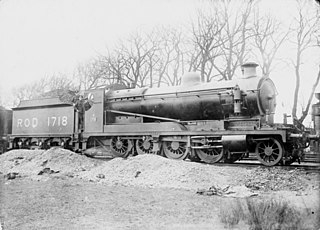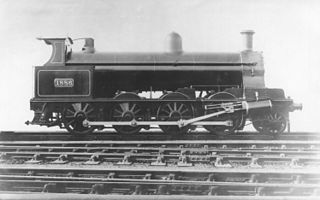The London, Midland and Scottish Railway had the largest stock of steam locomotives of any of the 'Big Four' Grouping, i.e. pre-Nationalisation railway companies in the UK. Despite early troubles arising from factions within the new company, the LMS went on to build some very successful designs; many lasted until the end of steam traction on British Railways in 1968. For an explanation of numbering and classification, see British Rail locomotive and multiple unit numbering and classification.

The steam locomotives of British Railways were used by British Railways over the period 1948–1968. The vast majority of these were inherited from its four constituent companies, the "Big Four".

The London, Midland and Scottish Railway Fowler Class 7F was a class of 0-8-0 steam locomotives. They were a Midlandised version of the London and North Western Railway (LNWR) Class G2 and Class G2A 0-8-0s. They were also classified as Class G3 under the former LNWR system. The class were sometimes known as Baby Austins, or Austin 7s, after a motor car that was becoming popular at the time.

The GWR 4100 Class was a class of steam locomotives in the Great Western Railway (GWR) of the United Kingdom.
The London, Midland and Scottish Railway (LMS) pioneered the use of diesel shunting locomotives in Great Britain. The variety of experimental and production diesel shunters produced by the LMS is summarised below.

The London, Midland and Scottish Railway (LMS) Stanier Class 5 4-6-0, commonly known as the Black Five, is a class of 4-6-0 steam locomotives. It was introduced by William Stanier and built between 1934 and 1951, of which 842 were built and were numbered 4658-5499. Several members of the class survived to the last day of steam on British Railways in 1968, and eighteen are preserved.

The London, Midland and Scottish Railway (LMS) Stanier Class 8F is a class of steam locomotives designed for hauling heavy freight. 852 were built between 1935 and 1946, as a freight version of William Stanier's successful Black Five, and the class saw extensive service overseas during and after the Second World War.

The London, Midland and Scottish Railway (LMS) Hughes Crab or Horwich Mogul is a class of mixed-traffic 2-6-0 steam locomotive built between 1926 and 1932. They are noted for their appearance with large steeply-angled cylinders to accommodate a restricted loading gauge.

The Great Central Railway (GCR) Class 8K 2-8-0 is a class of steam locomotive designed for heavy freight. Introduced in 1911, and designed by John G. Robinson, 126 were built for the GCR prior to the First World War. Including wartime construction for the British Army ROD and the post-war GCR Class 8M, the class and its derivatives totalled 666 locomotives.

The London and North Eastern Railway (LNER) Thompson Class B1 is a class of steam locomotive designed by Edward Thompson for medium mixed traffic work.

The London Midland and Scottish Railway (LMS) Fowler Class 4F is a class of 0-6-0 steam locomotive designed for medium freight work. They represent the ultimate development of Midland Railway's six coupled tender engines. Many trainspotters knew them as "Duck Sixes", a nickname derived from their wheel arrangement.

The Great Western Railway (GWR) 3000 Class was a class of 2-8-0 steam locomotive consisting of the ex-Railway Operating Division ROD 2-8-0. These were built by North British Locomotive Co. between 1917 and 1918. No examples have been preserved.

The Railway Operating Division (ROD) ROD 2-8-0 is a type of 2-8-0 steam locomotive which was the standard heavy freight locomotive operated in Europe by the ROD during the First World War.

The LNWR 1185 Class was a class of 0-8-2T steam tank locomotives designed by Charles Bowen-Cooke and introduced in 1911. They passed into LMS ownership in 1923 and 8 survived to British Railways ownership in 1948. British Railways numbers were 47875-47896.
The LMS (Northern Counties Committee)Class B3 4-4-0 passenger steam locomotives were rebuilds of Belfast and Northern Counties Railway (BNCR) two-cylinder compound locomotives. They operated services throughout the NCC's 5 ft 3 in (1,600 mm) broad gauge system in the north-east of Ireland.
The London and North Eastern Railway (LNER) Class O6 was a class of 2-8-0 steam locomotives of the Stanier Class 8F type.

The London and North Western Railway (LNWR) Class E was a class of 2-8-0 steam locomotives in service between 1904 and 1928.

The London and North Western Railway (LNWR) Class F was a class of 2-8-0 steam locomotives in service between 1906 and 1928.

The Caledonian Railway 721 Class was a class of 4-4-0 steam locomotives designed by John F. McIntosh for the Caledonian Railway (CR) and introduced in 1896. All survived to be absorbed by the London, Midland and Scottish Railway (LMS) in 1923 and a few survived into British Railways (BR) ownership in 1948.
The Caledonian Railway 55 Class were 4-6-0 mixed-traffic locomotives designed by John F. McIntosh and built at the railway’s St. Rollox works in Glasgow in 1902-1905. The class was intended for use on the Callander and Oban line and were sometimes known as Oban Bogies, a nickname they shared with the earlier Brittain 179 Class 4-4-0s and the subsequent Pickersgill 191 Class 4-6-0s, all of which were built for use on the same route.














